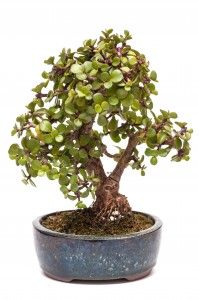 Jade trees, naturally grown in South Africa, are actually shrubs that grow well as bonsai. They are indoor bonsai that require temperatures above 50 degrees and like well-draining soil. These trees grow small rubbery leaves and expand rather quickly. Certain varieties of the Jade plant bonsai can display small white flowers and red-tipped leaves. These plants are extremely low maintenance, only requiring a large amount of sunlight and periodic watering.
Jade trees, naturally grown in South Africa, are actually shrubs that grow well as bonsai. They are indoor bonsai that require temperatures above 50 degrees and like well-draining soil. These trees grow small rubbery leaves and expand rather quickly. Certain varieties of the Jade plant bonsai can display small white flowers and red-tipped leaves. These plants are extremely low maintenance, only requiring a large amount of sunlight and periodic watering.
Watering Jade Bonsai
Your Jade plant bonsai should be watered enough to keep the soil moist, but allowed to almost dry out before watering. The leaves of the Jade tree store water, allowing the tree to go short periods with no water. This species is susceptible to root rot if they are consistently overwatered. This tree will enjoy periodic misting to wash away the dust that can collect on the cumbersome leaves.
Placement of your Jade Bonsai
Jade trees are indoor bonsai that need to be placed in a location that does not drop below 50 degrees. This tree also requires a large amount of natural sunlight; full sunlight is preferred for this species of bonsai.
Training Jade Bonsai
Jade plant bonsai respond well to heavy pruning, forcing more growth to compensate. New growth needs to be pinched back as it grows to maintain shape. Wire this tree with the thinnest wire that you can use to hold each branch. The wires should be removed from a Jade after 3-6 weeks, and the branch should then stay in place
Repotting Jade Bonsai
Jade plant bonsai need to be repotted every two years to replenish soil nutrients. If you can pull the Jade plant out of the pot and the dirt comes with the roots and maintains shape, it’s time to repot. Repot the miniature tree in well-draining or cactus soil. Jade bonsai prefer water to quickly run through the soil, like in the deserts of South Africa.
Fertilizing Jade Bonsai
Jade bonsai respond well to using a balanced fertilizer year round. We recommend that you feed your tree every other week all year. This species relies on fertilizers to provide nutrition since they are watered far less than other bonsai trees.
 |
 |
 |